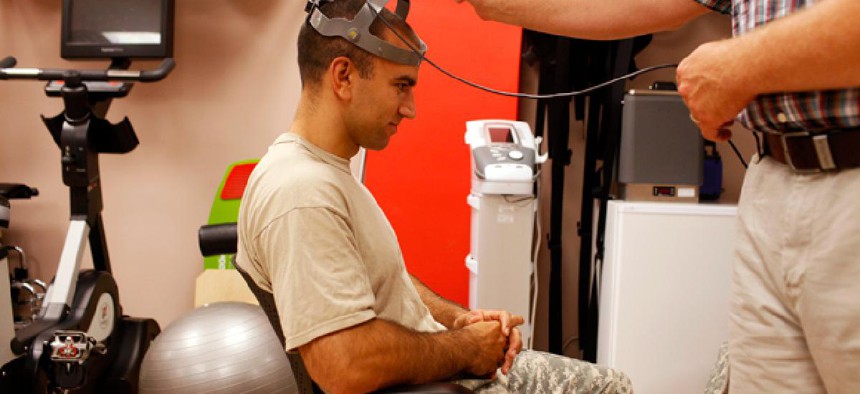The brain injury data project: One soldier's story

1st Lt. Timothy Dwyer has a sensor strapped to his head which will measure his head movement during cognitive testing at the Fort Campbell Army base in Fort Campbell, Ky. Josh Anderson/AP
Data from more than 10,000 brain injury patients -- including hundreds of variables and outcomes -- is being tracked in an ongoing government project that began 26 years ago.
You've been blown up, dude."
Those were the first words Corporal Toran Gaal heard upon awaking from a coma in a hospital bed in Walter Reed National Military Medical Center. Gaal was grateful that his brother, a former Marine, was so blunt.
A month earlier, right before dawn on June 26, 2011, the 24-year-old Marine squad leader had stepped on an improvised explosive device in Sangin, Afghanistan. When he opened his eyes at Walter Reed, Gaal wondered why he wasn't in country. Who was leading his men?
He says his limbs were an afterthought. The left leg would be amputated above the knee. Doctors would unsuccessfully try to salvage the right above the ankle, but it would eventually be taken at the hip. His brain's left frontal lobe was severely damaged. In less than a second, the trajectory of Gaal's life had changed. The infantryman, the college basketball player, the man always in control -- that person now lived in the past.
Gaal somehow manages not to dwell there. Still in recovery at the Naval Medical Center San Diego, he walks on prosthetics, rows, drives a car, and has plans to become an emergency services dispatcher. "I can't go back," he says. "I can't say what if, what if, what if. I'm happy with what I have. I'm alive."
Gaal's resilience can seem miraculous. He thinks of it as a trait he earned on the basketball court in adolescence and one that the military further "refined." Either way, his grit was a force that Gaal's doctors at the VA Palo Alto Polytrauma Rehabilitation Center, where he spent the first five months of his recovery, did not take for granted. Instead, it became leverage in their mission to see that Gaal's healing surpassed the average outcome for his injuries.
This was no wishful thinking; his doctors could compare Gaal's case to datasets based on thousands of civilian patients with brain trauma and other catastrophic injuries. Every day, Gaal's doctor, physical therapist, nurse, and case manager tapped into his urgent need to thrive, and pushed him just a little harder. Gaal knew they cared deeply, but it was hard to see that it was science.
***
Dr. Odette Harris, a neurosurgeon and associate chief of staff of polytrauma at the Palo Alto center, is a data hound. To her, resilience can be a "nebulous" term.
What she wants to know is how recovery might be measured in outcomes: how long will a patient stay in the hospital; will he be able to walk again; might she regain the ability to speak? Even the strongest willed patient is tied in some way to the fate of others who came before, demonstrating what the human body is capable of under a certain set of circumstances.
For a polytrauma physician, creating a treatment plan is more than an educated guess; it's built on decades of data known as the Traumatic Brain Injury Model Systems (TBIMS). Started in 1987 by the federal government, TBIMS is a prospective study that has tracked the recovery of more than 10,000 brain-injured patients using hundreds of variables and outcomes, including length of stay and what's known as a functional independence measure.
NEXT STORY: The drone secrets inside John Brennan





